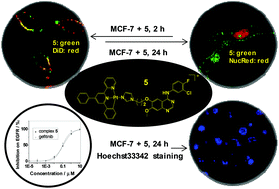当前位置:
X-MOL 学术
›
Inorg. Chem. Front.
›
论文详情
Our official English website, www.x-mol.net, welcomes your
feedback! (Note: you will need to create a separate account there.)
Luminescent cyclometallated platinum(ii) complexes: highly promising EGFR/DNA probes and dual-targeting anticancer agents†
Inorganic Chemistry Frontiers ( IF 6.1 ) Pub Date : 2017-12-11 00:00:00 , DOI: 10.1039/c7qi00346c Yang Zhang 1, 2, 3, 4, 5 , Qun Luo 1, 2, 3, 4, 5 , Wei Zheng 1, 2, 3, 4, 5 , Zhaoying Wang 1, 2, 3, 4, 5 , Yu Lin 1, 2, 3, 4, 5 , Erlong Zhang 1, 2, 3, 4, 5 , Shuang Lü 1, 2, 3, 4, 5 , Junfeng Xiang 1, 2, 3, 5, 6 , Yao Zhao 1, 2, 3, 4, 5 , Fuyi Wang 1, 2, 3, 4, 5
Inorganic Chemistry Frontiers ( IF 6.1 ) Pub Date : 2017-12-11 00:00:00 , DOI: 10.1039/c7qi00346c Yang Zhang 1, 2, 3, 4, 5 , Qun Luo 1, 2, 3, 4, 5 , Wei Zheng 1, 2, 3, 4, 5 , Zhaoying Wang 1, 2, 3, 4, 5 , Yu Lin 1, 2, 3, 4, 5 , Erlong Zhang 1, 2, 3, 4, 5 , Shuang Lü 1, 2, 3, 4, 5 , Junfeng Xiang 1, 2, 3, 5, 6 , Yao Zhao 1, 2, 3, 4, 5 , Fuyi Wang 1, 2, 3, 4, 5
Affiliation

|
Cyclometallated platinum(II) complexes, [(C^N^N)PtII(L)]n+ (n = 0 or 1), have attracted much attention due to their potency as luminescent probes for nucleic acids and anticancer agents. Reported herein are four [(C^N^N)PtII(L)]+ complexes (5–8, L = 4-anilinoquinazoline derivative) which exhibit a weak fluorescence emission over 605 to 627 nm upon excitation at 405 nm. The ligation of the cyclometallated platinum cores with EGFR-inhibiting anilinoquinazolines not only confers the resulting complexes with excellent EGFR-inhibiting potency with IC50 values at the nanomolar level, but also enhances their affinity to DNA, in particular to G-quadruplex (G4) DNA. Such interactions produce strongly luminescent EGFR and DNA complexes, respectively, allowing the easy tracing of the cellular uptake and distribution of the platinum complexes and make them potential fluorescent probes for both EGFR and DNA in living cells. Complexes 5 and 6 are highly cytotoxic to the cancer cell lines A549, HeLa, A431 and MCF-7, and selectively inhibit the EGF-stimulated growth of the MCF-7 cell line. Secondary-ion mass spectrometry imaging and ICP-MS analysis demonstrated that the platinum complexes localize both on the cell membrane and in the nuclei of cells associated with EGFR and DNA binding, respectively, further verifying their dual-targeting feature as anticancer agents.
中文翻译:

发光的环金属化铂(ii)配合物:前景广阔的EGFR / DNA探针和双重靶向抗癌药†
环金属化的铂(II)配合物[[(C ^ N ^ N)Pt II(L)] n +(n = 0或1),由于其作为核酸和抗癌剂的发光探针的作用而备受关注。本文报道了四种[(C ^ N ^ N)Pt II(L)] +配合物(5-8,L = 4-苯胺基喹唑啉衍生物),它们在405 nm激发后在605至627 nm处显示弱荧光发射。环金属化铂核与EGFR抑制的苯胺基喹唑啉的连接不仅使所得复合物具有优异的IC 50抑制EGFR的能力值在纳摩尔水平上增加,但也增强了它们对DNA的亲和力,特别是对G-四链体(G4)DNA的亲和力。此类相互作用分别产生强发光的EGFR和DNA复合物,从而易于追踪细胞对铂复合物的吸收和分布,并使它们成为活细胞中EGFR和DNA的潜在荧光探针。配合物5和6对癌细胞系A549,HeLa,A431和MCF-7具有高度的细胞毒性,并选择性抑制EGF刺激的MCF-7细胞系的生长。二次离子质谱成像和ICP-MS分析表明,铂配合物分别位于与EGFR和DNA结合相关的细胞膜和细胞核中,进一步证实了其作为抗癌剂的双重靶向特性。
更新日期:2017-12-11
中文翻译:

发光的环金属化铂(ii)配合物:前景广阔的EGFR / DNA探针和双重靶向抗癌药†
环金属化的铂(II)配合物[[(C ^ N ^ N)Pt II(L)] n +(n = 0或1),由于其作为核酸和抗癌剂的发光探针的作用而备受关注。本文报道了四种[(C ^ N ^ N)Pt II(L)] +配合物(5-8,L = 4-苯胺基喹唑啉衍生物),它们在405 nm激发后在605至627 nm处显示弱荧光发射。环金属化铂核与EGFR抑制的苯胺基喹唑啉的连接不仅使所得复合物具有优异的IC 50抑制EGFR的能力值在纳摩尔水平上增加,但也增强了它们对DNA的亲和力,特别是对G-四链体(G4)DNA的亲和力。此类相互作用分别产生强发光的EGFR和DNA复合物,从而易于追踪细胞对铂复合物的吸收和分布,并使它们成为活细胞中EGFR和DNA的潜在荧光探针。配合物5和6对癌细胞系A549,HeLa,A431和MCF-7具有高度的细胞毒性,并选择性抑制EGF刺激的MCF-7细胞系的生长。二次离子质谱成像和ICP-MS分析表明,铂配合物分别位于与EGFR和DNA结合相关的细胞膜和细胞核中,进一步证实了其作为抗癌剂的双重靶向特性。











































 京公网安备 11010802027423号
京公网安备 11010802027423号